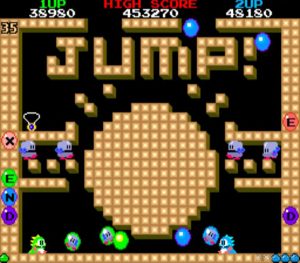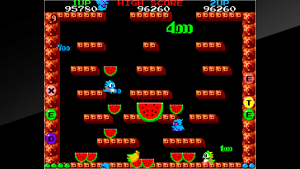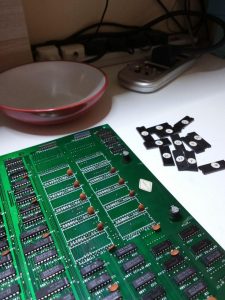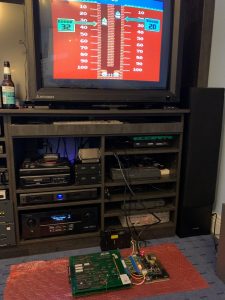DIY Guides, Howto & Guides
Building the Best Bubble Bobble

Super Mario Brothers may be regarded as the best and most influential platform game on home consoles, but when it comes to arcade platformers, gaming connoisseurs will often point to Bubble Bobble as being the best in the genre.
Designed in 1986 by the late Fukio Mitsuji, the game sees dragon brothers Bub and Bob (full names Bubblun and Bobblun) venture into the “Cave of Monsters” in order to rescue their girlfriends who have been captured by the evil Baron Von Blubba. You might consider two dragons fairly well equipped to take on monsters, but unlike conventional dragons however, the brothers can only blow bubbles.
The cave consists of 100 screens of platforms and enemies. Luckily, the enemies in the game can be defeated by blowing a bubble around them and then bursting the bubble. To clear a screen you simply defeat all the enemies.
The simple sounding concept is made into something really magical thanks to the games superb presentation, excellent graphics and catchy music. Furthermore, like most great video games, the game has plenty of hidden secrets, strategies and techniques. It was a game you could enjoy as a casual player, depositing a coin to pass ten minutes, or as a core player, spending all of your hard earned pocket money mastering the games many stages.
The game was ported to dozens of home systems spanning several generations. Debate rages online as to which is the best home version, but for the real experience you should definitely look to the arcade. However, even using MAME or buying your own JAMMA board might not get you the Bubble Bobble experience Mitsuji intended. To understand why, we have to know a little bit about some of the magic behind the game and just how those bubbles really bobble.
When random isn’t random

Ask any computer scientist about random number generation and they will tell you that generating truly random numbers on a computer is not a trivial thing to do. A computer isn’t self aware, you can’t simply ask it to “choose” a number. Any random number has to come from somewhere. The offshoot of this is that seemingly random numbers generated by a computer often fall into a pattern. Indeed, astute slot machine players have, in the past, been able to work this to their advantage when playing fruit machine/slot machine type casino games.
Bubble Bobble on the other hand, uses this pseudo-randomness to its advantage. What seems like a random appearance of an item or special enemy may actually be something you can manipulate to your advantage, if you find the secret of the sequence. The chip that is responsible for this controlled chaos is called PS4 (no, not PlayStation 4). It’s a pseudo-random number generator that wouldn’t find favour in a casino, but is brilliant for a game such as Bubble Bobble.
Bubble Bobble was a huge hit in arcades and it wasn’t long before bootleg manufacturers brought out their own versions. While these are very similar to a casual observer, the bootleggers weren’t able to completely reverse engineer the PS4 chip, and so to a seasoned player these bootleg boards actually play quite a bit differently to a genuine board. Even MAME, the arcade emulator, wasn’t able to emulate this chip accurately until recently.
To this day, the best way to play Bubble Bobble is still on an original PCB with a genuine PS4 chip. Boards of this nature change hands for close to a thousand euros, however.
Redux to the rescue
Sure, you could play the Saturn port of Bubble Bobble, or even play it on MAME, but now, thanks to Bubble Bobble Redux, there’s a more authentic way of doing it without completely breaking the bank. Bubble Bobble Redux is a ROM hack (or perhaps, a hack of a hack) that patches the bootleg versions of the game, making their pseudo-random number generator work much more accurately compared to the original PS4 chip.
If you’re a fan of Bubble Bobble it’s now possible to pick up a bootleg PCB and install the Redux ROMs, turning it into something very much closer to an original board.
The Lost Cave
As we said at the beginning of the article, Bubble Bobble was ported to dozens of home systems. Many of those home versions had extra content not found in the arcade game. In particular, home ports had additional levels compared to the arcade.
While many home ports are good, they can’t usually hold a candle to the arcade version. Imagine if you could play all that extra content on the arcade original, with the best possible graphics and sound.
Amazingly, you now can. Bubble Bobble Lost Cave was released back in 2013 and brings 100 of the best levels from the home versions right into the arcade original. One of the best and most creative arcade ROM hacks we have come across, Lost Cave is a must play for fans of the game.
Time to build Bubble Bobble

We recommend anyone try Bubble Bobble and Lost Cave via any of the great ports that are out there or perhaps using MAME. If you want an even more authentic experience however, you can now pick up a bootleg Bubble Bobble JAMMA board, pair it with a Supergun or home arcade cabinet and get the full arcade experience in your home.
Here, we called on the experience of our partners at BetaGamma computing. We set them a task, build us the best Bubble Bobble PCB possible. Boy, were we in for a treat. Not only did we get a fully working version of Bubble Bobble Redux but, thanks to BetaGamma’s excellent engineering skills, we got Lost Cave on the same PCB too, all selectable by DIP switch. This really is the best Bubble Bobble ever! We reached out to BetaGamma computing to ask how they achieved this, and what was involved in giving an old, beaten up bootleg PCB all this new pop.
Can you give us an overview of the work you did on the board?
Before starting any modifications, the boards were thoroughly inspected (the game comes on two PCBs). We replaced some of the power line filter caps to ensure a nice clean and steady 5V and 12V supply.
The main work involved in the modification was the removal of all existing Masked ROMs which were soldered directly to both PCB’s. Extreme care was taken not to damage any pads or through hole plating during the removal process. The empty ROM sockets were then populated with high quality turned pin sockets. After the boards were cleaned of flux residue a full continuity check was carried out to ensure no damage had occurred.
The ROM sockets are 28 pin types supporting 27C256 or 32K x 8 bit capacity and, thankfully, of standard pin-out.
How did you achieve Bubble Bobble Classic and Lost Cave on the same PCB?
Since we wanted the flexibility of running the Lost Cave ROM on the same PCB, the ROM capacity had to be doubled over the original 32k board. 27C512 ROM’s are 64 x 8 bit capacity so by toggling the highest address line of the ROM we can select either the top 32K or bottom 32K.
A custom ROM set was compiled combining both Redux and Lost Cave into Hi and Lo segments. This was then programmed on to modern Winbond W27C512 EEPROMs. These devices have very high compatibility and a fast access speed of 45nS which is far quicker than the board actually needs so there is plenty of headroom.
The two boards were then re-wired slightly to isolate this additional A15 address line on the W27C512 and combine it throughout the set. This then allowed us to provide a toggle switch to either ground A15 or leave it high via a 4k7 resistor. It was now possible to switch between the two games using this switch.
Using a redundant line in the IDC cable connecting both boards helped transfer A15 between the boards.
Finally the boards were fully cleaned and reassembled using extra supports to provide a sturdy self-standing assembly.

Bubble Bobble is a timeless classic. New graphics and more powerful systems have failed to deliver a more satisfying version of the game. The recent “Bubble Bobble For Friends” game, while still a great game in its own right, doesn’t manage to recreate all the magic of the original. If you want a piece of video game history and one of the best ROM hacks ever, then get yourself a Bubble Bobble/Lost Cave dual board just like we did.
Extra special thanks to our friends and partners at BetaGamma computing for making this possible. BetaGamma specialise in repairs and modifications for classic consoles, computers and arcade boards. If you have a project in mind, get in touch with us today and BetaGamma could be building your dream computer, arcade machine or console in the near future!


Wow! You guys figured that out all by yourselves? };-P
https://elgensrepairs.blogspot.com/2014/04/bubble-bobble-lost-cave-redux-on-same.html
(PS: Why didn’t you even post a link?!)